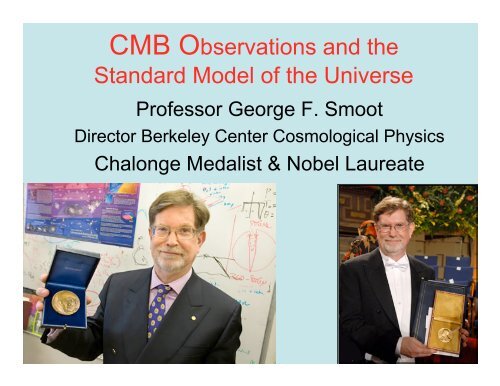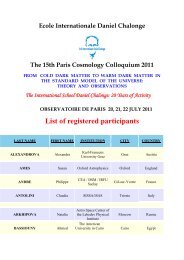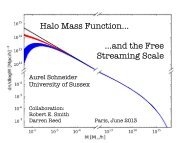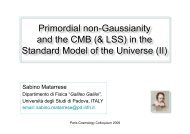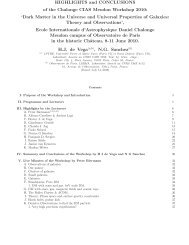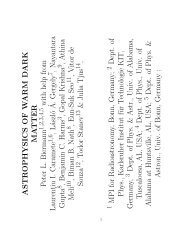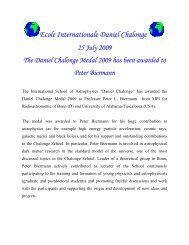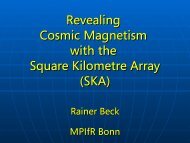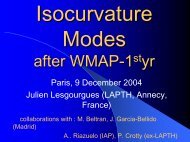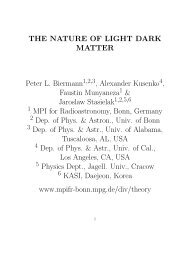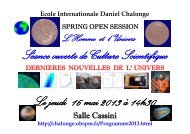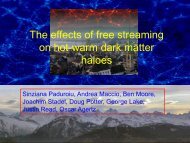George F. SMOOT (.pdf)
George F. SMOOT (.pdf)
George F. SMOOT (.pdf)
Create successful ePaper yourself
Turn your PDF publications into a flip-book with our unique Google optimized e-Paper software.
CMB Observations and the<br />
Standard Model of the Universe<br />
Professor <strong>George</strong> F. Smoot<br />
Director Berkeley Center Cosmological Physics<br />
Chalonge Medalist & Nobel Laureate
Simple Beginning<br />
Complex Present
Hot<br />
Dense<br />
Smooth<br />
Fluctuation generator<br />
Cool<br />
Rarefied<br />
Clumpy<br />
400<br />
Brief History of<br />
our Universe<br />
Fluctuation amplifier<br />
(Underlying Graphics from Gary Hinshaw/WMAP team)
Cosmic Archaeology<br />
CMB: direct probe<br />
of quantum<br />
fluctuations<br />
Time: 0.003% of<br />
the present age of<br />
the universe.<br />
(When you were<br />
0.003% of your<br />
present age, you were<br />
2 cells big!)<br />
Cosmic matter<br />
structures:<br />
less direct probes<br />
of expansion<br />
Pattern of ripples,<br />
clumping in space,<br />
growing in time.<br />
3D survey of<br />
galaxies and<br />
clusters - Lensing.<br />
Supernovae:<br />
direct probe of<br />
cosmic<br />
expansion<br />
Time: 30-100%<br />
of present age<br />
of universe<br />
(When you were<br />
12-40 years old)
Foreground-cleaned WMAP map from Tegmark, de Oliveira-Costa & Hamilton, astro-ph/0302496<br />
CMB<br />
History
CMB<br />
+<br />
P(k)<br />
ρ b /(1.8788×10 −26 kg/m 3 )<br />
From Max Tegmark<br />
How much dark matter is there?<br />
Apply CMB & LSS<br />
Why are we<br />
cosmologists so<br />
excited?<br />
=ρ d /(1.8788×10 −26 kg/m 3 )
CMB<br />
+<br />
P(k)<br />
ρ b /(1.8788×10 −26 kg/m 3 )<br />
How much dark matter is there?<br />
=ρ d /(1.8788×10 −26 kg/m 3 )
CMB<br />
+<br />
P(k)<br />
ρ b /(1.8788×10 −26 kg/m 3 )<br />
How much dark matter is there?<br />
Ruled out by CMB 2000<br />
(COBE, Boomerang, MAXIMA, etc)<br />
=ρ d /(1.8788×10 −26 kg/m 3 )
CMB<br />
+<br />
P(k)<br />
ρ b /(1.8788×10 −26 kg/m 3 )<br />
How much dark matter is there?<br />
=ρ d /(1.8788×10 −26 kg/m 3 )
CMB<br />
+<br />
P(k)<br />
ρ b /(1.8788×10 −26 kg/m 3 )<br />
How much dark matter is there?<br />
=ρ d /(1.8788×10 −26 kg/m 3 )
CMB<br />
+<br />
P(k)<br />
ρ b /(1.8788×10 −26 kg/m 3 )<br />
How much dark matter is there?<br />
=ρ d /(1.8788×10 −26 kg/m 3 )
How flat is space?<br />
flat<br />
closed<br />
open
How flat is space?
How flat is space? Somewhat.
How flat is space?<br />
Ω tot=1.003±0.010
386<br />
430<br />
13.8
Using<br />
WMAP3 +<br />
SDSS LRGs:<br />
75%<br />
4%<br />
21%
Where are we Really?<br />
• With Very Simple Assumptions<br />
• And Physics Rules<br />
• We can predict the history and evolution<br />
of the Universe to the per cent level of<br />
agreement with observations<br />
• This is a great stochastic agreement.<br />
Great similarity to Thermodynamics in<br />
late 19 th century.
Thermo - Stat Mech Analogy<br />
• With the development of atomic and molecular<br />
theories in the late 19th century, thermodynamics<br />
was given a molecular interpretation. This field is<br />
called statistical thermodynamics, which can be<br />
thought of as a bridge between macroscopic and<br />
microscopic properties of systems.<br />
• Statistical thermodynamics is an approach to<br />
thermodynamics based upon statistical mechanics,<br />
which focuses on the derivation of macroscopic<br />
results from first principles.*<br />
* In physics, a calculation is said to be from first principles, or ab initio, if it starts directly at the level of established lawss<br />
of physics and does not make assumptions such as model and fitting parameters.
Ideal Gas Law<br />
• PV = n R T (= N k B T) Equation of State involving<br />
only macroscopic quantities: P, V, n, T<br />
• Molecular Model - The ideal gas law can also be<br />
derived from first principles using the kinetic theory of<br />
gases, in which several simplifying assumptions are<br />
made, chief among which are that the molecules, or<br />
atoms, of the gas are monatomic point masses,<br />
possessing mass but no significant volume, and<br />
undergo only elastic collisions with each other and<br />
the sides of the container in which both linear<br />
momentum and kinetic energy are conserved.<br />
• PV = N k B T = N KE DOF = N m /2
Our Macroscopic Cosmology<br />
Standard Microphysics & Content plus<br />
1) Inflation = simple scalar field<br />
2) Dark Matter = CDM<br />
3) Dark Energy = Λ or SSF<br />
4) Matter-antimatter asymmetry = yes<br />
And the nots:<br />
5) No significant other relics to be found (e.g.<br />
cosmic strings)<br />
6) No extra dimensions significant<br />
7) Fundamental constants don’t vary<br />
8) Other exotic forces in play?
Evolution of single over dense lump<br />
comoving coordinates<br />
Daniel Eisenstein 2006
Evolution of Lumps Components
MICROPHYSICS AND<br />
THE DARK UNIVERSE
THE DARK UNIVERSE<br />
The problems appear to be completely different<br />
DARK MATTER<br />
• No known particles<br />
contribute<br />
• Probably tied to<br />
M weak ~ 100 GeV<br />
• Several compelling<br />
solutions<br />
DARK ENERGY<br />
• All known particles<br />
contribute<br />
• Probably tied to<br />
M Planck ~ 10 19 GeV<br />
• No compelling<br />
solutions
DARK MATTER<br />
NEW QUESTIONS<br />
– What is its mass?<br />
– What are its spin and other<br />
quantum numbers?<br />
– Is it absolutely stable?<br />
– What is the symmetry origin of the<br />
dark matter particle?<br />
– Is dark matter composed of one<br />
particle species or many?<br />
– How and when was it produced?<br />
– Why does Ω DM have the observed<br />
value?<br />
– What was its role in structure<br />
formation?<br />
– How is dark matter distributed<br />
now?<br />
DARK ENERGY<br />
– What is it?<br />
– Why not Ω Λ ~ 10 120 ?<br />
– Why not Ω Λ = 0?<br />
– Does it evolve?<br />
BARYONS<br />
– Why not Ω B ≈ 0?<br />
– Related to neutrinos,<br />
leptonic CP violation?<br />
– Where are all the<br />
baryons?
DARK MATTER<br />
Known DM properties<br />
• Gravitationally<br />
interacting<br />
• Not short-lived<br />
• Not hot<br />
• Not baryonic<br />
Unambiguous evidence for new physics
RELIC DENSITY DETERMINATIONS<br />
LHC (“best case scenario”)<br />
ILC<br />
WMAP<br />
(current)<br />
LCC1<br />
Planck<br />
(~2010)<br />
% level comparison of predicted Ω collider with observed Ω cosmo<br />
ALCPG Cosmology Subgroup
IDENTIFYING DARK MATTER<br />
Congratulations!<br />
You’ve<br />
discovered the<br />
identity of dark<br />
matter and<br />
extended our<br />
understanding of<br />
the Universe to<br />
T=10 GeV, t=1<br />
ns (Cf. BBN at<br />
T=1 MeV, t=1 s)<br />
Yes<br />
Yes<br />
Yes<br />
No<br />
Are you<br />
sure?<br />
Did you<br />
make a<br />
mistake?<br />
Think about<br />
dark energy<br />
Are Ω collider and Ω cosmo identical?<br />
Yes<br />
No<br />
No<br />
No<br />
Ω cosmo<br />
Can you discover<br />
another particle<br />
that contributes<br />
to DM?<br />
No<br />
Yes<br />
Does it account<br />
for the rest of<br />
DM?<br />
Which is bigger?<br />
No<br />
Ω collider<br />
Does it<br />
decay?<br />
Yes<br />
No<br />
Can you identify a<br />
source of entropy<br />
production?<br />
No<br />
Calculate<br />
the new<br />
Ω hep<br />
Yes<br />
Yes<br />
Can this be resolved with some nonstandard<br />
cosmology?
Microphysics must produce<br />
Macro-Universe from first Principles<br />
• Extremely well-constrained by observations and<br />
macro-Cosmological model<br />
• Guided by symmetry principles and theoretical<br />
constructs - e.g. string theory inspired.<br />
• New concepts and questions arise:<br />
– What was the universe like before the Big Bang?<br />
– By the anthropic principle we are mostly to be a<br />
construct in some one’s simulation.
Great Discovery Era Unfolds …<br />
COBE DMR WMAP & Planck
An image of quantum fluctuations<br />
blown up to the size of the universe.
Primordial Perturbations<br />
• Originate as quantum fluctuations in<br />
Inflationary scenario<br />
• CMB maps on the largest scales are faithful<br />
impression of quantum fluctuations<br />
• Each blob is about a single quantum<br />
– Our own Galaxy (The Milky Way) was a quantum<br />
fluctuation in the early universe<br />
– So were other galaxies and clusters of galaxies.<br />
• The expanding universe is a better microscope<br />
than any laboratory imager
Cosmological Koans<br />
• CMB anisotropies are simultaneously the<br />
largest and smallest entities’ images in<br />
Nature.<br />
• The Universe began with almost no<br />
information.
Why is the Information Content<br />
of the Observable Universe<br />
so very small?<br />
• Physically conceivable: 10 180 bits<br />
• Holographic Principle: 10 120 bits<br />
• Inflationary Universe: 10 10 bits<br />
• Observable Fluctuations: 10 8 - 10 9 bits<br />
• Cosmological Parameters: 20 parameters at<br />
about 12 bits plus equations of physics and<br />
statistics<br />
Data Compression?
Sometimes you need a genius or great intuition
The Future:<br />
The Person of the 21st Century
CONCLUSIONS<br />
• Cosmology now provides sharp problems that are<br />
among the most outstanding in basic science today.<br />
• They require new microphysics, solutions rely on the<br />
intimate connection between large and small<br />
• This field may be transformed by the end of this decade


